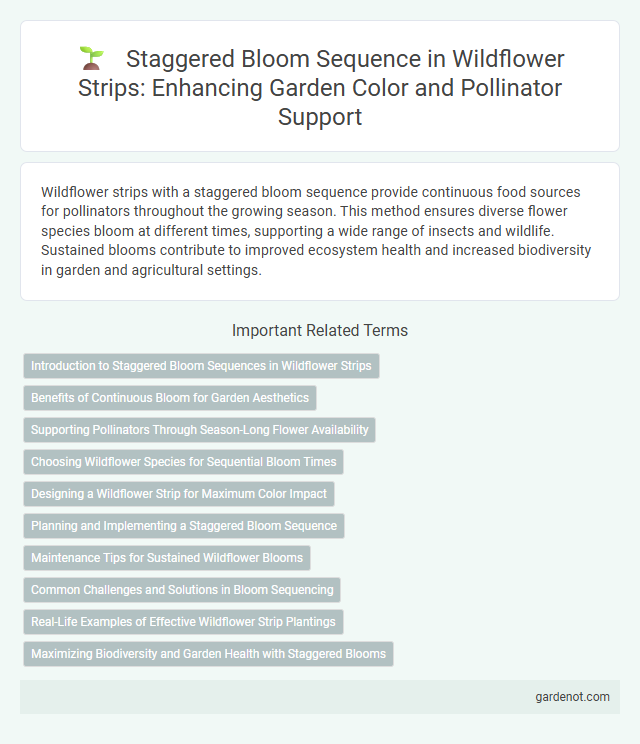Wildflower strips with a staggered bloom sequence provide continuous food sources for pollinators throughout the growing season. This method ensures diverse flower species bloom at different times, supporting a wide range of insects and wildlife. Sustained blooms contribute to improved ecosystem health and increased biodiversity in garden and agricultural settings.
Introduction to Staggered Bloom Sequences in Wildflower Strips
Staggered bloom sequences in wildflower strips ensure a continuous display of flowers throughout the growing season, enhancing habitat for pollinators such as bees and butterflies. By carefully selecting species with varying bloom times, these strips provide sustained nectar and pollen sources, supporting biodiversity and ecosystem health. This strategic planting approach optimizes plant resilience and promotes ecological balance in natural and agricultural landscapes.
Benefits of Continuous Bloom for Garden Aesthetics
A staggered bloom sequence in a wildflower strip ensures continuous color and texture throughout the growing season, enhancing garden aesthetics by preventing bare or dull periods. This ongoing floral display attracts pollinators like bees and butterflies consistently, contributing to a vibrant, lively ecosystem within the garden. Continuous bloom fosters dynamic visual interest and supports biodiversity, making the wildflower strip a key design element for sustainable and visually appealing landscapes.
Supporting Pollinators Through Season-Long Flower Availability
A staggered bloom sequence in wildflower strips ensures continuous availability of nectar and pollen, crucial for supporting diverse pollinators throughout the growing season. By selecting native plant species with varied flowering periods, these strips provide habitat and food resources from early spring to late fall. This sustained floral resource supports pollinator health, promoting ecosystem stability and enhancing crop pollination services.
Choosing Wildflower Species for Sequential Bloom Times
Selecting wildflower species with staggered bloom times ensures continuous floral display from early spring to late fall, maximizing habitat value for pollinators. Incorporating early bloomers like Lupinus perennis, mid-season species such as Echinacea purpurea, and late bloomers like Solidago canadensis sustains nectar and pollen availability throughout the growing season. This sequential bloom strategy enhances biodiversity, supports pollinator populations, and maintains ecosystem resilience in wildflower strips.
Designing a Wildflower Strip for Maximum Color Impact
Designing a wildflower strip with a staggered bloom sequence ensures continuous color throughout the growing season, enhancing visual appeal and ecological benefits. Selecting species like Black-eyed Susan (Rudbeckia hirta), Coneflower (Echinacea purpurea), and Coreopsis that bloom at different times creates overlapping floral displays. This approach maximizes pollinator attraction while maintaining vibrant aesthetics from early spring to late fall.
Planning and Implementing a Staggered Bloom Sequence
Planning a staggered bloom sequence in a wildflower strip involves selecting species with varied flowering periods to ensure continuous color and resources for pollinators from spring through fall. Implementing this sequence requires careful sowing schedules and spatial arrangements to promote successive blooming while maintaining ecological balance and soil health. Monitoring growth stages and adjusting plant density optimize pollination and enhance habitat value for beneficial insects.
Maintenance Tips for Sustained Wildflower Blooms
Implement a staggered bloom sequence in your wildflower strip by selecting species with varying flowering periods, ensuring continuous color and resources for pollinators throughout the growing season. Regularly deadhead spent flowers and mow the strip once late in the season to prevent woody growth and encourage reseeding. Monitor soil moisture and remove invasive weeds promptly to maintain healthy, sustained wildflower blooms year after year.
Common Challenges and Solutions in Bloom Sequencing
Staggered bloom sequences in wildflower strips often face challenges such as uneven flowering times and limited pollinator attraction, which can reduce ecological benefits and aesthetic appeal. To address these issues, planting a diverse mix of species with overlapping bloom periods and adjusting sowing times ensures continuous floral availability. Implementing site-specific management practices, like soil preparation and maintenance, further enhances bloom synchronization and supports sustained pollinator activity.
Real-Life Examples of Effective Wildflower Strip Plantings
Wildflower strips with staggered bloom sequences enhance biodiversity by providing continuous forage for pollinators throughout the growing season. In a study from the UK's agri-environment schemes, strips planted with species like Cornflower (Centaurea cyanus), Field Poppy (Papaver rhoeas), and Oxeye Daisy (Leucanthemum vulgare) demonstrated extended flowering periods lasting from spring to late summer. This approach not only supports diverse insect populations but also improves crop pollination and pest control on adjacent farmland.
Maximizing Biodiversity and Garden Health with Staggered Blooms
A wildflower strip designed with a staggered bloom sequence ensures continuous flowering from early spring to late fall, supporting a diverse range of pollinators throughout the growing season. By selecting species with varying bloom times, the habitat promotes sustained nectar and pollen availability, enhancing ecosystem resilience and garden health. This approach maximizes biodiversity, attracts beneficial insects, and fosters a balanced environment that reduces pest outbreaks naturally.
Staggered bloom sequence Infographic

 gardenot.com
gardenot.com